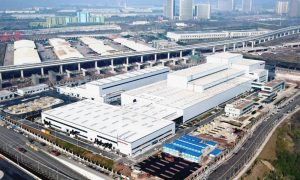Land of plenty
Jordan’s big business

It may not be oil-rich, but education, finance and legislative models mean Jordan is on the edge of big business. Dan McAlister investigates the potential of the Middle East’s new promised land
By 2020, one in every 83 people living in Jordan will be an engineer, rising to one per 50 by 2040. Jordanian universities produce 5000 engineers every year and the country has the highest literacy rate in the Arab world.
Unsurprisingly, Jordan’s construction industry is booming as a result.
The country’s largest planned urban development project to date, King Abullah bin Abdul Aziz City is well under way; the Queen Alia Airport is due for completion this year; affordable housing plans are in action; and a comprehensive high-way masterplan underpins the improvement strategy for Jordan’s 9000km of four lane, two lane and rural roads, taking part between 2010 and 2030.
The development will be needed to support a population predicted to double by 2025, due to constant and rapid immigration.
“According to the Jordan Investment Board, there are currently 150 project ideas and 75 pre-feasibility studies as part of the investment map. Several of these opportunities are in the construction industry,” explains AECOM’s manager of special projects, Firas Tarawneh.
“According to government sources, there will be a number of buildings or infrastructure projects that will be launched between 2012 and 2015 as part of the country’s overall economic growth,” Tarawneh adds.
Unlike the development of its affluent neighbours, Jordan’s growth will not be funded by oil revenues. Instead the country has developed an exhaustive PPP model, with the support of built asset consultancy EC Harris and McBains Cooper on a 12 month advisory basis, in collaboration with K&L Gates and the Jordan-based Darat Consulting. Funding will partly be provided by the World Bank.
The aim of the exercise is to increase the efficient use of Jordan’s public buildings portfolio; of which there are 10,000 across the country.
EC Harris, will act as programme manager and technical advisor to the Directorate of Government Buildings.
“The Jordanian Government is one of the few governments in the region to recognise the need to improve how they manage real estate,” says EC Harris partner, Bernie Devine.
“The contract we have with the department is to centralise the management of their properties portfolio. Establishing an efficient process is a critical component to maximising the return on investments. We are helping them to understand how to manage the portfolio better,” he adds.
The vast portfolio of public buildings is characterised by long term underinvestment, with many in need of refurbishment or replacement. The only significant private sector developments on Amman’s horizon are the major hotel chains such as Hilton, Four Seasons and Continental.
In terms of the public sector market in Jordan, EC Harris head of property Paul Foster believes that there is a serious potential for investors to take over and contractors agree: Jordan is a country with political stability and a favourable business environment.
“The issue is the funding and that’s why Jordan established a Department of Privatisation a couple of years ago. It doesn’t take long to realise that there is a real PPP potential in Jordan and there may well be even more funded by capitalist money,” Foster says.
Decisive action
The mechanisms for growth exist; even in 2009 when other countries were faced with economic ruin, Jordan was largely unscathed and to this day banks are ensuring liquidity in the industry, according to a report by the Oxford Business Group, which stated that 2009 was “something of a paradox”.
“Decision making in Jordan is not as quick as we’re used to do in some western economies but they make sound and cautious decisions that aren’t slow because of paralyses but diligence. We are in the process of starting to see that come through,” Foster asserts, praising the “superb” leisure and hotel developments, which are yet to reach their maturity and “maximize their true potential”.
In terms of initiating the new projects, Jordan’s tendering regulations are managed by its General Tendering Directorate and monitored under the Investment Promotion law that: “Attracts many regional investments and eases stringent regulations to provide freedom from customs and grant investment guarantees,” Foster says.
One area where foreign companies may find themselves disadvantaged is in the boardroom, where many meetings and conversations around the project table are conducted in Arabic, rather than English, as favoured in other Middle East countries.
Safety issue
In a 2010 article, Jordan’s Journal of Civil Engineering stated that: “Even though construction labour accounts for about 7.1% of the labour force, the Occupational Safety and Health Institute (OSHI) in Jordan reports that accidents in the construction industry accounts for about 10.5% of incidents.”
Foster echoes: “The health and safety market in Jordan is not as advanced as the rest as the UAE or in Qatar. They are a couple of years behind in terms of planners.”
He adds that despite this, the country is “very well organised” in terms of its standards of education concerning safety matters.
“They are catching up very quickly. Even the duration of the building period on the Taj Mall project for example, we have seen that develop to actually reaching an international standard” he says.
Engineering a future
Jordan’s engineering army looks set to steer the development of the country in the short to mid-term, with the sector largely responsible for the development of the construction industry, through the implementation of professional standards.
Last year the Jordan Engineers’ Association (JEA) signed an agreements with BuildingSMART MENA, BuildingSMART ME, BIM Journal and Jordan’s Ministry of Public Works, to establish a BIM forum focused on the continued development and efficiency of BIM in the country’s construction industry.
At the time of signing, a survey conducted by BuildingSMART ME, found only 5% of construction professionals in Jordan were utilising the software.
It will be an invaluable tool considering a 20% overall growth rate is predicted for the country’s construction industry throughout the next five years, due in a large part to the needs of a growing population.
Cost Competitive Location
- Jordan offers a low cost manufacturing platform and a quicker delivery for building materials serving a regional construction market
- Tax and duty exemption benefits for entry to Arab markets through Free Trade Agreements
- Relatively low overall labour costs compared to regional competitors
- Policy and regulatory environment
- The policy and regulatory environment around the Jordanian construction industry is relatively light
- Few licenses are required specifically for the trades and support
- Current project include the $1 billlion Abdali Urban Regeneration; “Jordan Gateway”; “Royal Village”; Saraya Aqaba and Aqaba Prototype City. The near future will see both residential (75%) and commercial (25%) markets continuing to expand.
- Supporting this growth will be a string of major infrastructure works, such as vast real estate projects; transportation projects including rail, airports and ports; municipality developments under the Amman Master Plan and Salt Master Plan; and the development of the Red Sea to Dead Sea Canal among others.





















